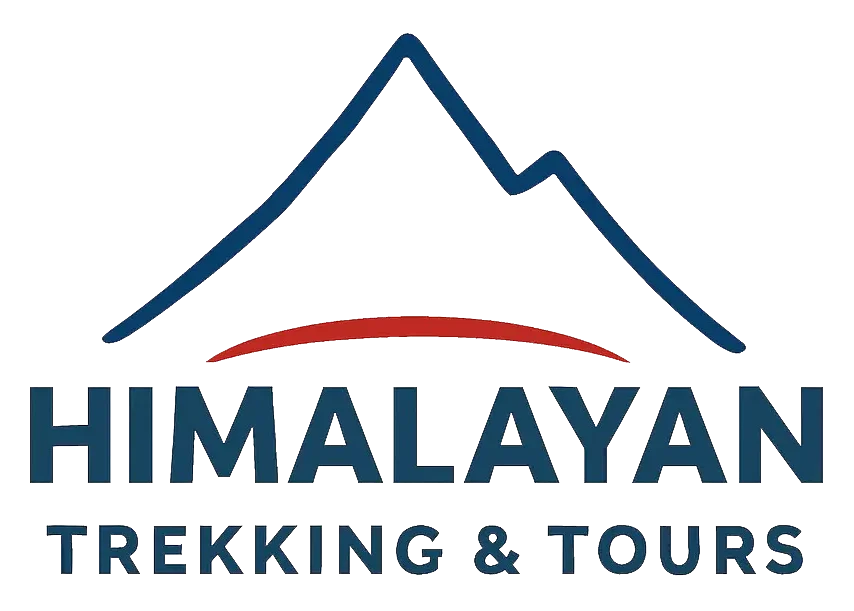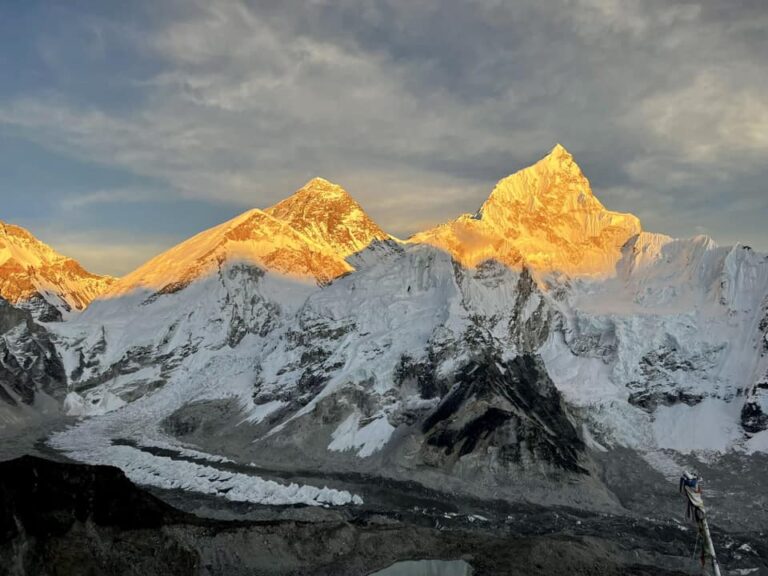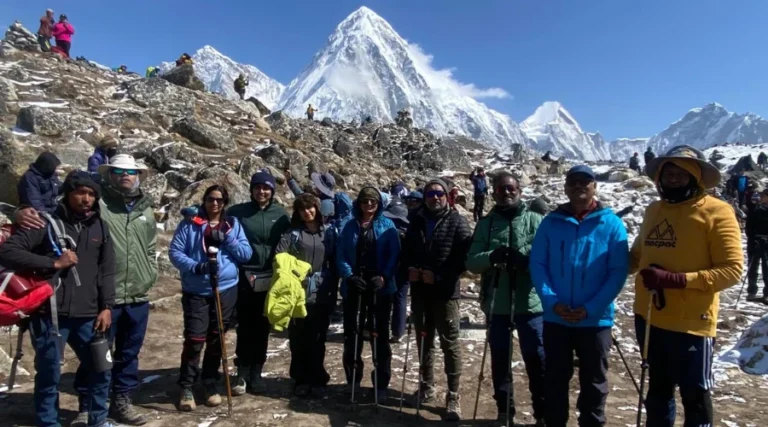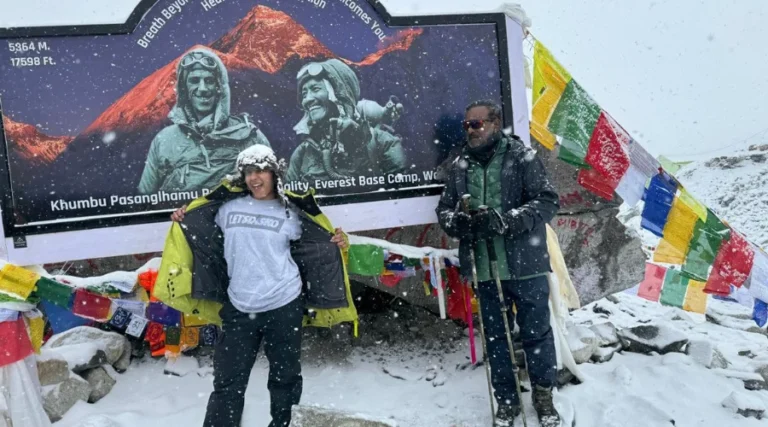Gokyo Lake to Everest Base Camp Trek
-

Trip Duration 18 Days
-

Max, Altitude 5555 Meters
-

Type Standard
-

Best Season Sept - May
-

Meals Included
-

Accommodation Guest House
-

Activity Trekking
-

Difficulty Strenuous
- Majestic view of Everest, Makalu and Lhotse, and other Himalayan mountains.
- Visit the turquoise Gokyo Lakes, a height above 4500 meters.
- Trek through Sherpa villages and vibrant local culture.
- Climbing Gokyo Ri for panoramic mountain views.
- Explore the Ngozumpa Glacier, the queen glacier of Nepal.
- Scenic trekking through lush forests and alpine meadows.
- A less crowded choice for the Everest Base Camp Trek.
- Crossing Cho La Pass and continuing on the amazing historical Everest Base Camp Trek is feasible.
The Gokyo Lake to Everest Base Camp trek is popular in the Everest region of Nepal. It has breathtaking landscapes, cultural encounters, and outstanding personal conquests.
It starts in Lukla and follows the Dudh Koshi River valley to the Gokyo Lakes. From Gokyo, the trail ascends to Cho La Pass (5420m), Thukla, and Lobuche before reaching the Everest Base Camp.
Along the way, you will get spectacular views of Mt. Everest, Mt. Lhotse, Mt. Nuptse, Mt. Makalu and other great peaks.
Gokyo Lake to Everest Base Camp Trek Overview
The Gokyo Lakes to Everest Base Camp Trek is one of the least challenging treks in Nepal’s Himalayas. It offers a fantastic view of the Gokyo Lakes, a series of blue waters at the base of glaciated limestone lakes.
You will see Everest, Makalu, Lhotse, and the rest. This EBC route option has almost the same scenery but fewer crowds.
Gokyo Lakes to Everest Base Camp Trek the town of Lukla, Sherpa villages, the forest, and the plains. As they proceed, they learn about the culture and hospitality of the people in the region.
After walking for a full day, they reach Gokyo, the starting point of the four leading lakes. Here, they can enjoy splendid views of the accompanying mountains and the Ngozumpa glacier, the longest glacier in Nepal.
Further up, the destination is Gokyo Ri, an alpine town station with excellent views of surrounding hollows or lakes. You can see the whole Himalayan range, including Everest and many other peaks.
The challenge will be the altitude because the hike is moderate, but because it brings people to the stature of the Himalayas without leaving the comfort of their resident valley, it is worth it.
The Gokyo Lakes to Everest Base Camp Trek is not a simple hike despite containing elements of hiking activity. However, it also offers the opportunity to learn about the Sherpa people.
Namche Bazaar, Dole, and so on, the villages through which the route passes in the Khumjung region, are also traditional places, and they provide a general idea of authentic village life in the local area on a day-to-day basis.
Crossing the city, one can see Buddhist wats, prayer flags and old Chedi. Such cultural activities provided an extra dimension of beauty to the climb and turned the experience into one of a kind.
About Gokyo Lakes
The Gokyo Lakes are a set of six glacial lakes in Nepal’s Everest region. These lakes are known for photographing the most extraordinary turquoise waters and what lurks beings that live within the snow.
Lakes at high altitudes (4700 to 5000 m) are natural beauty that a hiker could reflect during a trail. The leading lakes of Gokyo are Gokyo Lake, Tanjung Lake, Longpongo Lake, Taboche Lake, Ngozumpa Tsho, and Rakshay Tsho.
More than just a scenic spot, these lakes are religiously significant to the aboriginal Sherpa.
Everest Gokyo Lakes Trek Distance
The shortest distance travelled by the walks depends on the path selected and already travelled (the total distance walked in the trek is 70-80 km or 43-50 miles).
There is also an option to change the trek route. The duration is 10-12 days, and the daily distance between subjects is 6-10 km.
Trekking starts in Lukla and passes through villages (Namche Bazaar, Dole, and Machhermo), ending in Gokyo Lakes. The roads are medium-length, but the road surfaces are rough due to terrain and the world’s topographical limitations.
Kathmandu to Gokyo Lake Distance
The distance between Kathmandu and Gokyo Lake is approximately 135 km (84 mi). However, the distance is more significant because the tour involves flight and walking.
Following by air, you fly 138 km (86 mi) to Lukla from the capital city Kathmandu.
Short Itinerary
Itinerary of Gokyo Lake to Everest Base Camp Trek
Meet our airport representative at the airport and transfer to hotel. It takes about 30 minutes drive from Airport to hotel. You will be staying in Thamel which is a tourist hub. Free and easy and trip preparation. Overnight at hotel.
Early in the morning, our guide will pick you up from the hotel and take you to Ramechhap Airport, about 4 4-hour drive from Kathmandu. Then, fly to the Tenzing Hillary Airport in Lukla. Upon arrival, we will start the trek to Phakhing. The trail comes around the Dudh Kosi Valley before going uphill to Phakding.
We will cross a river. All thanks to a suspension bridge and uphill following the shoreline to Chumoa. We will sit for some good coffee at coffee shops there. Afterward, we will walk through the forest and different small villages. The last two hours, uphill climb to Namche Bazaar village, also know with the nicknamed of the capital of Sherpa.
Because of the altitude sickness, you will have a free Day in Namche Bazaar. But if you are feeling good and want to explore, you could hike to Syangboche Everest View Hotel (the highest hotel in the world) to observe close view of Mt. Everest, Amadablam, Thamserku, Lhotse.
The trail will start with gradual ups and downs and we could be lucky to see Himalayan animals like, pheasants or musk deer. We will go down to Dudhkoshi Khola and go up through rhododendron forest before reaching Phorse. This place is a good view point on Tawache and Cholaste mountains.
Our trail will pass through forests, waterfalls and bridges before to reach Dole. Afterward we will climb steady on a scenic ridge and walk above the DudhKoshi River and through small villages. Once arrival in Machherma, if you want, you could visit the Himalayan Rescue Hospital
The trail climbs and gives an excellent view of Kantaga and Big Mountain Cho-oyu. Then, we descend to the riverbank and climb to the moraine of the Ngozamba Glacier.
We will pass through high-altitude lakes Longpongo, RabocheTsho, and DudhPokhari. We will take time to enjoy these landscapes before finally reaching the beautiful high-altitude lake Gokyo.
We must climb on a steep trail to enjoy the most beautiful and peaceful view of Gokyo Lake, with a mountain range in the background. We will spend time on the top to enjoy the beauty of the landscape.
Afterwards, we will go to Gokyo, and you can rest or explore the lake.
The trail will start to go up and down the glaciers before it descends along the valley to reach the base camp of Thangana.Get your camera out. The trail offers beautiful views of mountains and the natural beauty of the area.
The trail to reach Cho La Pass comes to a glacier. It is not difficult but we have to be careful, it is vertical and the iced rocks are slippery. After reaching Cho La Pass, enjoy the panoramic view of various mountains.
From here, the trail descends all the way to Dzongla, passing through some crevasses and pine forests with some beautiful viewpoints.
Today, the trail is more relaxing. It is a pleasant walk to enjoy the excellent views that the trip provides of AmaDablam, the Nuptse-Lhotse, Everest, Pumori, and Lobuche Peak.
The small and lovely village of Lobuche, near the stream, is a perfect spot to watch the sunset on Nuptse.
Today, we will finally go uphill to reach the Everest Base Camp—the highest peak in the world. The trek trail is on the glacier and offers a view of Mount Everest.
When you reach the base camp, you will see many frozen lakes and an impressive view of Khumbu Icefall. Enjoy this unforgettable experience before getting down to Gorakshep.
Early in the morning, we will hike up to Kalapatthar. This peak offers the best view of the Everest summit during the entire trek. Enjoy the view and take some photos to remember this breathtaking moment.
Now, it’s time to go back, and after your great ascension, the trail down will seem easy.
On the way, you could see the heritage of Buddhism with some magnificently mani “carved stones”, and we will walk through the colourful vegetation of rhododendrons.
Upon arrival at the monastery, you can appreciate the view of different mountains, especially during sunset or sunrise. Tengboche Monastery is an essential place for Sherpas of the Solukhumbu area.
The trail will mostly downhill to Namche Bazaar.
This is your last trekking Day, which will finish in the same place when we started the trek: in the city of Lukla.
Morning you will take a flight from Lukla to Ramechhap/Manthali and drive back to Kathmandu. Free time at your leisure.
We will transfer you to the airport and hoping you spent a beautiful time with us.
Lukla Flight Information
The weather conditions in the mountain region of Nepal can change rapidly, and aviation schedules are not as reliable as you might expect. The flight between Ramechhap/Manthali and Lukla is frequently delayed and may be cancelled for the day or several days. In the event your flight is cancelled we will either rebook your flight for the following day. It is recommended to apportion one or two extra days in case your flight gets cancelled and you are short of scheduled time.
Price includes
- Kathmandu Airport – Hotel – Airport transfer by Private vehicle
- Three Meals (Breakfast, Lunch and Dinner) during the trek
- Tea and Coffee during the trek
- Twin Sharing Accommodation at Kathmandu at 3 star hotel with breakfast
- Twin sharing accommodation during the trek
- National Park Entry Fee, Local Government Entry fee
- Domestic Flight from Kathmandu/Ramechhap to Lukla and Return
- 1 Experienced guide for the group of 2 to 10 and assistant guide for a group above 10
- One porter assigned for two people to carry luggage
- Our Staff’s daily meal, wage, equipment, insurance and allowances
- First aid kit with high-altitude medicines
- Duffel bag and Sleeping bag (Must be returned after completion of the trek)
- Trek completion certificate (Upon request)
- Our Service Charges
Price Excludes
- International airfare, Nepal Visa and travel insurance
- Meals in Kathmandu except breakfast
- Extra night accommodation in Kathmandu ( early arrival or flight cancellation etc)
- Personal expenses such as shopping, Laundry, Internet, Phone call etc
- Drinking water, cold drinks and alcohol drinks
- Gratuities for staff
Have any Questions? Check out FAQ'S
Trip Essential Information
Difficulty of Gokyo Lakes Trek to Everest Base Camp
Gokyo Lakes Trek is categorized as moderate to complex due to its high altitude and slopes. Perhaps the most challenging part of the route is Gokyo Ri (5,357 m), a viewpoint. Climbing is also severe and arduous with altitude.
Preventing altitude sickness requires physical fitness and a decrease in walking speed. Indeed, by the time one gets to the top, the extraordinary views of Everest, Lhotse, and the ranges behind are worth the effort.
Altitude Sickness During Gokyo Lakes Trek
The Gokyo Lakes Trek is a high-altitude trek that ends at Gokyo Ri (5,357 m). The higher the altitude, the more likely trekkers are to experience symptoms of altitude sickness, such as headache, vertigo, and nausea.
Most trekkers should be prepared to pre-plan at least 1-2 days of rest for 100% acclimatization at significant trek breaks on the route, such as Namche Bazaar or Do le.
The inability to adapt to oxygen (hypoxia) at altitude directly relates to the influence of altitude sickness (elevation sickness). Hydration, nutrition, and avoiding excessive exertion are critical to minimise risk.
There is an urgent need for a lower altitude to be descended if even one or more of the above symptoms persist, and medical treatment needs to be sought.
Despite the trail’s difficulty due to gradients, adequate acclimatization and preparation make it manageable enough for most trekkers to complete the hike.
Hiking at altitude demands good physical fitness and psychological preparedness for acclimatization to potential fatigue.
Not only is Gokyo Lakes Trek a physically demanding, if not even exhausting, experience and endurance-based, but its more challenging days at altitude are pretty demanding.
Due to exercise preceding travel, physiological conditioning may increase endurance and provide something to look forward to for the journey.
Food during the Gokyo Lakes to Everest Base Camp Trek
Food is provided during the Gokyo Lakes trek, a blend of Sherpa ethnic food, typical Western food, and other cuisines.
The menu includes food selections such as dal bhat (a mixture of lentils and rice), momos (dumplings), mixed vegetables, and chicken curry.
As the food supply increases, the more remote the level, the more restricted the food selection for consumption, but the more basic items that can be eaten still exist.
The further you climb the food range, the more comfortable it becomes. In certain circumstances, a broad range of food is scaled down to dal bhat, noodle purées, and at least potatoes.
Most tea houses have this simple menu, which includes food and snacks such as chocolate bars, cookies, and energy drinks.
Adequate hydration during hiking is also a significant factor; hence, the amount of water and tea consumed is substantial. Some trekkers also use water purifying tablets to sanitize drinking water safely.
However, there is not necessarily much variation in what is consumed in the Everest region. Still, it supplies the energy for the climb and is a culturally rich part of the experience.
Gokyo Lakes to Everest Base Camp Trek Accommodation
At the Gokyo Lakes Trek, accommodation is based on tea houses, which are small lodges, providing a very simple but very comfortable one. Tea rooms are usually outfitted with a furniture bed, which can be moved, and a shared bathroom.
Rooms are small, clean, almost certainly have a wooden floor and are, per definition, equipped with an extremely large vitrine in the direction of a mountain or a village.
Although basic facilities are available, they are adequate for trekkers who wish to stay close to safe, comfortable resting places after a hard day of walking.
At lower parts of the trek, e.g., Namche Bazaar or Dole, tea houses have better facilities (wet laundry facilities including the possibility at the tea houses to wash clothes together with linen laundry with washing points for an electronic device).
Tea houses play a significant role in Nepal, in addition to trekking, not only as a place of refuge, comfort and belonging for trekkers who trek themselves but also for trekkers who have trekked with others from around the world.
Typical Day During EBC and Gokyo Lakes Trek
You will wake up around 6-7 a.m. After breakfast, you will begin your trek. Lunchtime is mainly in the afternoon, usually at a village or roadside tea stall.
The stopover is brief yet tolerable, so hikers can get some fresh air, drink some drinks, maybe eat, and then return home.
In the late afternoon, say midday, the walk continues—a further 3-4 hours of relatively low-pace movement up or down after the itinerary’s completion point.
As the altitude increases, the trekking days may be harrowing; however, the spectacle is ever more rewarding.
At lunchtime, trekkers arrive at their daily endpoint, usually a tea chalet or a guest lodge where they can rest. The evening is best for chilling out, as there is an evening meal, and all the trekkers get to know one another.
Dinnertime is a family tradition of typical Nepali food, like dal bhat or Italian food, which includes pasta and stews/soups. The day will most often (i.e., after a very early bedtime at night) end with the next day’s commencement at sunrise.
Permits For EBC and Gokyo Lakes Trek
To trek to Everest Base Camp (EBC) and Gokyo Lakes, you need a Sagarmatha National Park permit and a Khumbu Pasang Lhamu Rural Municipality permit.
These permits are necessary for the site, Sagarmatha zone, where the two treks are situated. The Sagarmatha National Park Permit is around NPR 3,000 (foreign hikers), and the Khumbu Pasang Lhamu Permit is around NPR 2,000 (hikers).
Such permits are on offer in Kathmandu or at the Monjo border point before entry into the national park.
Travel Insurance
It’s advisable to hire a tour with a trip to Gokyo Lakes and The Everest Base Camp; one should book travel insurance.
Therefore, adequate insurance services for travellers should cover medical expenses, operations, luggage loss, and trip cancellation.
For instance, being insured for high-land trekking is helpful because all the complications that may occur at height require helicopter evacuation. The insurance policy shall be correctly executed in case of altitude sickness and rescue.
Everest Base Camp Gokyo Lakes Trek Cost
The cost of a Gokyo Lakes Trek can vary by season and trekking distance (budget or luxury, etc.). Budget treks will likely cost between $700 and $1200 per person, including permit fees, guides, porters, meals, and accommodation fees.
The expense tends to be between $2000 and $3000, or slightly higher, depending on the 5-star hotel, meals, and other provisions.
Best Time for Everest Base Camp Gokyo Lakes Trek
The Gokyo treks are also best done in the autumn (September-November) and spring (March-May) seasons.
Autumn (September to November):
Trekking in Nepal is most popular in the autumn season. The days are warm, the nights are cold, and, therefore, the best and most breathtaking views of the Himalayas are captured.
Relatively favourable conditions and average temperatures favour the trek. There is little wilting this monsoon season, making the trails dry, and the trekking conditions are also quite good.
Spring (March to May):
Gokyo Lakes Trek also runs into winter, as with many other good seasons. The weather is good, and rhododendron flowering plants cover the tracks, making them pleasant to walk on.
The sky is blue, with a beautiful view of the mountainscapes. It’s another busy season for hikers, resulting in more people on the trail.
Winter (December to February):
Winter’s weather is cold, especially in the high elevations, and the track can get icy with deep snow. The climate is peaceful and quiet for the trekking season, even if there are relatively few trekkers now. However, winter is a trek only for experienced hikers to the Gokyo Lakes Trek.
Monsoon (June to August):
The monsoon season is the worst time to trek in Gokyo Valley because of the continuous rains. During these months, the tracks are muddy, wet, and slippery.
Landslide risk is also present in some regions with greater susceptibility to land sliding. It is proposed that it is better not to climb during monsoons.
Drinking Water in Everest Base Camp Gokyo Lakes Trek
Hydration is especially crucial for the Gokyo Lakes Trek. Bottled water is provided along the route, but it is also better to treat the water with water purification tablets or a filter to make it potable.
Many trekkers also refill reusable water bottles to reduce plastic waste. Drink lots of water to avoid dehydration at altitudes where the air is arid and thin.
WiFi, Electricity, and Communication
WiFi and electricity are easy to get in the Everest Base Camp Gokyo Lakes Trek, mostly at tea houses during the Gokyo Lakes trek, where their presence drops rapidly at higher elevations.
WiFi is available cheaply (predominantly in the larger hamlets, such as Namche Bazaar and Gokyo). However, the connection may be slow or unreliable.
Electricity is usually supplied by solar power or generators. However, it is recommended that you always carry a power bank to charge your devices.
Communication could be through compromised links in remote areas. However, voice calls and message transmission through mobile networks like Ncell can be used in some parts of the country.
MAP
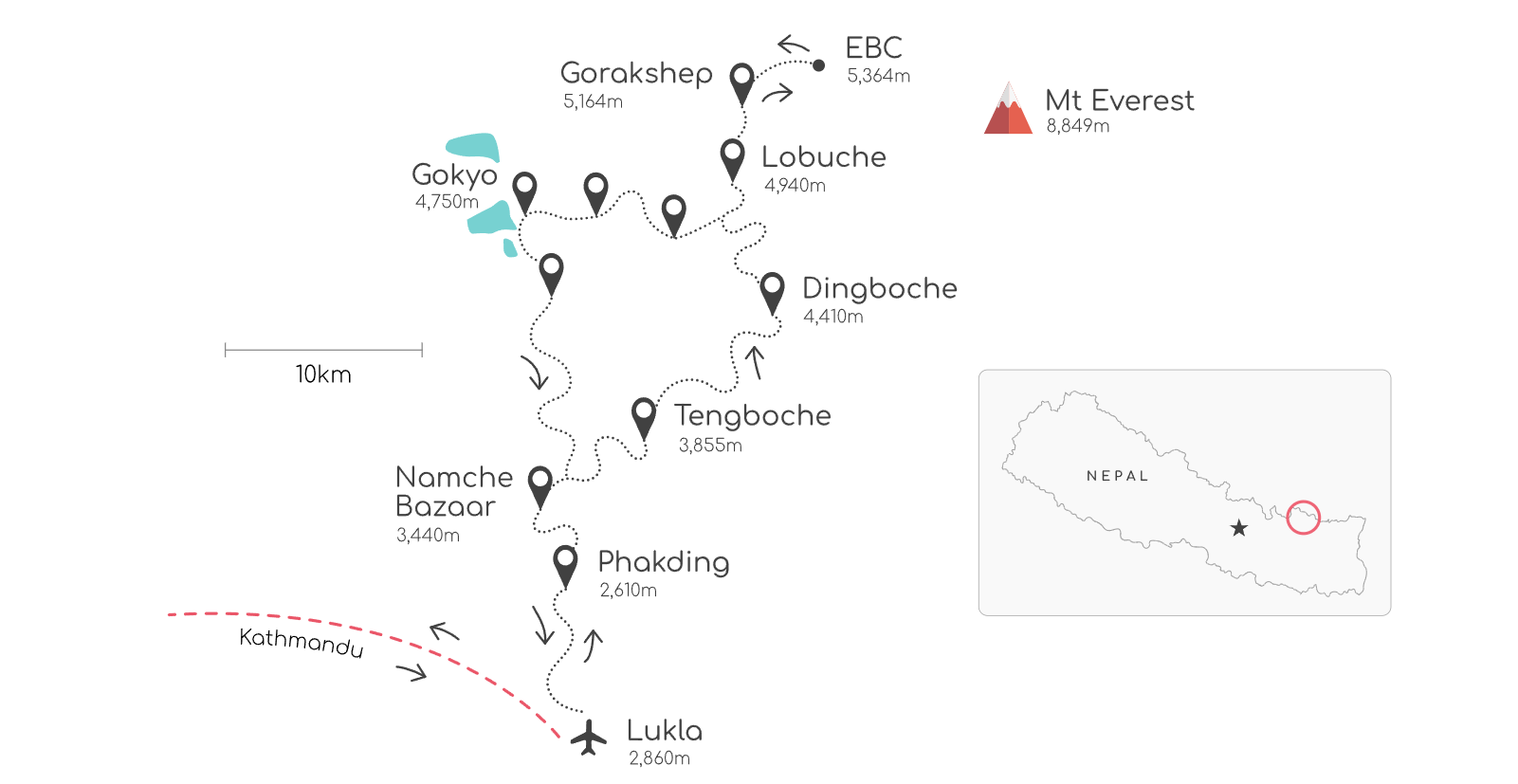
Frequently Asked Questions (FAQ)
Swimming in Gokyo Lakes is very difficult due to the freezing temperatures of the water and the extreme climate. Although some people have tried it, it is impossible and, in some cases, fatal.
Trekkers may reach Gokyo Lakes by flying from Kathmandu to Lukla Airport and trekking to Namche Bazaar. The trek takes 2-3 days.
Yes, climbing up Gokyo Ri is well appreciated as a success worth excellence. This gives a stunning view of Mount Everest, Cho Oyu, Makalu, and Ngozumpa Glacier, making the trek very interesting.
Mount Everest can be seen from Gokyo Ri, but the view is unclear. However, magnificent dry views of the mountain and several other high-pointed peaks can be obtained from the summit.
Gokyo Ri lies at a height of 5,483 meters or 18,319 feet above sea level.
From Gokyo Ri, trekkers get to see some of the great mountains, including Mount Everest, Cho Oyu, Makalu Lhotse, and Ngozumpa Glacier.
Though Gokyo Lake measures different parts in different areas, no available source provides precise measurements of its depth.
The lakes are crystal-clear, bottomless, and formed by glaciers that have crossed the area in the past.
Gokyo Lake is located in the Solukhumbu district of Nepal, within the northeastern part of the Sagarmatha zone.
- Instant Confirmation
- Free to customize
- Support anytime
© 2025 - Himalayan Trekking and Tours (P) Ltd. All Rights Reserved.
